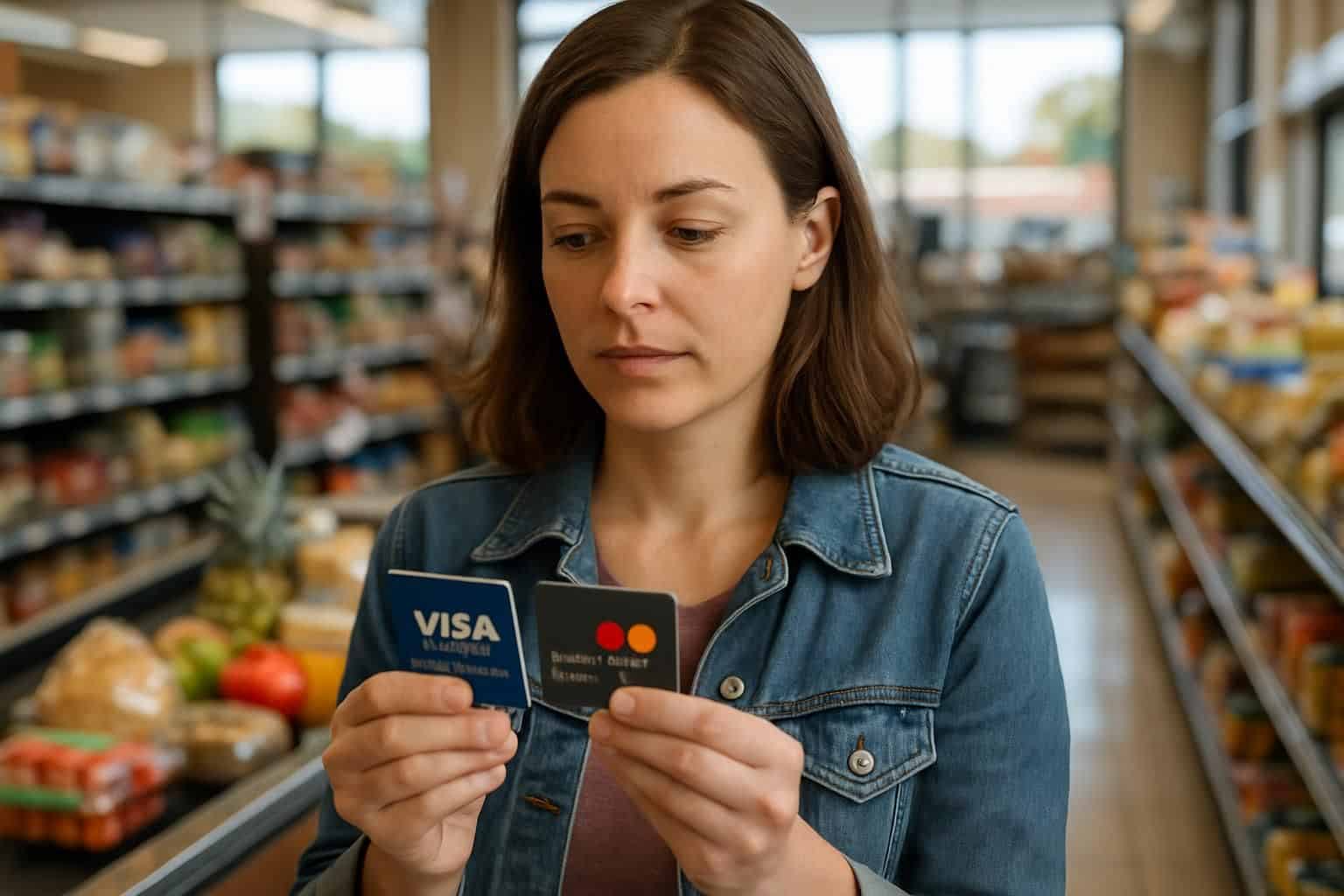You’re standing at the checkout, holding two gift cards, wondering which one to pick. Both Visa and Mastercard control nearly the entire payment network market, with Visa holding 52% of global transactions.
This guide breaks down the Visa vs Mastercard gift card debate, covering fees, acceptance rates, and regional differences to help you make the smart choice. Ready to find your perfect match?
Key Takeaways
Visa holds 52% of global market share and works at 44 million locations, while Mastercard operates at 40 million spots worldwide.
Visa activation fees range $2.95-$6.95 compared to Mastercard’s higher $3.95-$7.95, but Mastercard offers better international transaction rates at 0.5%-2.5%.
Visa dominates in the U.S. and Asia with near-universal acceptance, while Mastercard leads in Europe with 35% of EU transactions.
Both cards charge inactivity fees after one year of non-use, with Visa offering standardized 7-year expiration versus Mastercard’s variable policies.
Mastercard allows $1,000 maximum balance compared to Visa’s $500 limit and provides more customization options for personal and corporate use.
Table of Contents
Key Similarities Between Visa and Mastercard Gift Cards

Both Visa and Mastercard gift cards function as prepaid debit cards that work at millions of locations worldwide, offering similar security features and fraud protection. You can buy Visa gift card online on Eneba, among other purchasing options. These payment methods share common ground in terms of acceptance at major online retailers, ATMs, and physical stores, making them reliable alternatives to traditional credit cards or cash.
Where can I use Visa and Mastercard gift cards?
Visa gift cards work at over 44 million locations worldwide, while Mastercard gift cards function at more than 40 million spots globally. You can use these prepaid cards at most retailers, restaurants, gas stations, and online stores.
Nearly all U.S. merchants accept visa cards and mastercards for purchases. I’ve personally used both types at Target.com, grocery stores, and countless online retailers without issues.
Virtual Visa gift cards redeem at any internet, mail order, or phone merchant that takes visa debit cards. Mastercard gift cards work universally at any location accepting mastercard debit cards.
These payment methods integrate with mobile wallets like Apple Pay and Google Pay for contactless payments. Some stores even let you split payments between your gift card and another payment method, making shopping more flexible for larger purchases.
How secure are Visa and Mastercard gift cards?
Security features are essential for your gift card experience, with both networks offering fraud protection measures. These include zero-liability policies for promptly reported unauthorized transactions.
Cardholders are protected against unauthorized charges through these comprehensive safety measures. The zero-liability policy provides reassurance for consumers concerned about digital transaction risks.
Visa and Mastercard have enhanced their security with advanced technological features. Visa uses a biometric Payment Passkey Service for secure online verification, improving online shopping safety.
Mastercard uses AI technology for real-time cybersecurity improvements in digital transactions. Security features may differ depending on the issuing bank or credit union, not just the network.
Both cards offer strong protection against unauthorized transactions, providing effective security whether you’re purchasing groceries or shopping through apps like Google Play or the App Store.
Security feature improvements are expected as a future trend for both networks.
Do Visa and Mastercard gift cards have fraud protection?
Both Visa and Mastercard gift cards come with zero liability policies that protect you from unauthorized transactions. These policies mean you won’t pay for fraudulent purchases if someone steals your card information or uses your gift card without permission.
Banks and credit unions that issue these prepaid cards enforce the protection, though specific features can vary between different financial institutions.
You must report suspicious activity quickly to get full fraud protection benefits. Mastercard sometimes offers SMS alerts through certain issuers, giving you instant notifications about transactions.
Both networks push strong protocols at the network level, while individual banks add their own layers of protection. Gift card companies market these fraud protections as major selling points, and the policies ensure cardholders face no liability for unauthorized use.
These protections work similarly to those found on regular checking accounts and credit products from major banks.
Now let’s examine how acceptance varies by region for these two gift card networks.
Key Differences Between Visa and Mastercard Gift Cards

While both cards work similarly, Visa and Mastercard gift cards differ in key areas that affect your daily use. These differences include where merchants accept them globally, what fees you’ll pay, and how long your card stays active before expiring.
How does acceptance vary by region for Visa and Mastercard gift cards?
Visa’s global dominance shows clearly in different regions, with the company holding 52% of the global market share. In the United States and Asia, Visa gift cards work almost everywhere, from major retailers like Walmart and Target to gas stations and food trucks.
Square payment systems at small vendors readily accept Visa cards, making them the go-to choice for American shoppers. CVS and other major pharmacy chains stock Visa gift cards more frequently than Mastercard options.
Mastercard’s strength lies in Europe and Latin America, where it processes 35% of all EU transactions. European merchants, especially in countries like France and Germany, often prefer Mastercard for their payment processing systems.
Some small Parisian bakeries and local vendors may have limited Mastercard acceptance, but the brand still outperforms Visa in most European markets. Mastercard reaches over 210 countries compared to Visa’s 200-plus network, giving it a slight edge for international travelers.
The prepaid Mastercard options work particularly well for e-commerce transactions in European markets, where banking regulations favor Mastercard’s tokenization technology.
Geography matters more than brand loyalty in the gift card world, your location determines which plastic wins.
What are the fee differences between Visa and Mastercard gift cards?
Beyond regional acceptance patterns, the fee structures between these two payment networks show clear differences that impact your wallet.
| Fee Type | Visa Gift Cards | Mastercard Gift Cards |
|---|---|---|
| Activation Fees | $2.95–$6.95 | $3.95–$7.95 (often higher) |
| Foreign Transaction Fees | ~3% | 0.5%–2.5% |
| Inactivity/Dormancy Fees | After 1 year of no use | After 1 year of no use |
| Transaction Fees | Rare | 0.5%–2.5% for foreign transactions |
| Balance Check Fees | Possible (check fine print) | Possible (check fine print) |
| Replacement Fees | Possible (check fine print) | Possible (check fine print) |
| Holiday Fee Waivers | Some retailers (Kroger, Safeway) waive fees | Some retailers (Kroger, Safeway) waive fees |
| International Cards | Standard foreign transaction fees apply | May offer 0% foreign transaction fees |
Visa cards generally carry lower activation fees compared to Mastercard options. I’ve noticed this difference consistently across major retailers like Target and Walmart. Mastercard compensates with better international fee structures, especially their specialty international cards.
Both networks may hit you with dormancy charges after twelve months of inactivity. Always review the fine print before purchasing either card type. Some retailers waive activation fees during holidays, making gift card purchases more appealing.
Foreign transaction fees favor Mastercard users. Their 0.5% to 2.5% range beats Visa’s standard 3% charge. This advantage becomes significant for international online shopping or travel purchases.
Balance check fees and replacement costs vary by issuer rather than network. Card packaging typically lists these charges clearly. Smart buyers compare total costs, not just activation fees, before making their choice.
How do expiration policies differ for Visa and Mastercard gift cards?
While fees grab attention first, expiration policies create the bigger headache for gift card holders down the road.
| Policy Feature | Visa Gift Cards | Mastercard Gift Cards |
|---|---|---|
| Standard Expiration Period | Fixed 7 years from issue date (per U.S. CARD Act) | No fixed expiration, varies by issuer |
| Typical Range | 5-7 years in most cases | Valid until balance reaches $0 or set period expires |
| Policy Consistency | More standardized across issuers | Varies significantly by card issuer |
| Inactivity Fees Impact | May void card before 7-year expiration | Can drain balance to $0, ending card validity |
| Dormancy Period | Fees start after 1 year of non-use | Fees begin after 1 year of inactivity |
| Balance-Based Expiration | Expires on date regardless of remaining balance | Often expires when balance hits zero |
My experience managing gift cards for family members revealed Visa’s predictable seven-year timeline makes planning easier. Mastercard policies require checking each issuer’s specific terms since they vary wildly. Both card types face the same one-year inactivity threshold before fees kick in, potentially draining your balance faster than expected. Smart users set phone reminders to use cards within 12 months to avoid dormancy charges that can kill the card early.
Pros of Visa Gift Cards

Visa gift cards shine with their widespread acceptance and user-friendly features that make spending your money easier and more convenient across different platforms and locations.
Why is Visa gift card acceptance high in the U.S. and Asia?
Visa dominates the U.S. and Asian markets with a commanding 52% global market share, making acceptance nearly universal across these regions. Over 44 million locations worldwide accept Visa, with the strongest concentration in American and Asian markets where the brand is deeply integrated with point-of-sale systems.
Major U.S. retailers like Walmart, Target, and CVS stock Visa gift cards prominently, while gas stations, food trucks, and small vendors using Square readers process Visa transactions efficiently.
Visa gift cards work consistently at everything from corner stores to major department stores across both regions.
Visa’s payment network connects directly with the vast majority of merchant systems in these areas, creating an ecosystem where rejection rarely occurs. The company’s strong brand recognition in the U.S. and Asia translates to merchant confidence and consumer reliability, driving widespread adoption.
Small business owners often choose Visa-compatible systems first because they know customers expect this option. This creates a positive feedback loop where high acceptance drives more usage, which encourages even more merchants to support the network, solidifying Visa’s position as the preferred choice for domestic shoppers and online purchases throughout these markets.
Are Visa gift cards better for online shopping?
Visa gift cards dominate the online shopping space with impressive numbers. These cards work at 99% of U.S. online retailers, making them incredibly reliable for digital purchases.
Major platforms like Amazon accept Visa’s payment system without issues, which boosts your shopping confidence. Virtual Visa gift cards handle all internet, mail order, and phone purchases where Visa debit cards work.
Digital versions can be added to Apple Pay and Google Pay, streamlining your checkout process.
Fraud protection features make Visa’s online transactions particularly secure for tech-savvy shoppers. The company’s market leadership in online retail creates a smooth experience across different websites and apps.
Digital gift-giving becomes effortless with instant delivery options for virtual cards. You can even learn how to add a gift card to PayPal to expand your payment options further.
Strong digital infrastructure supports quick processing and immediate card activation.
Visa’s compatibility with major platforms like Amazon enhances online shopping reliability, making it the go-to choice for digital purchases.
Now let’s examine where Visa gift cards might fall short in certain situations.
What fees are typically lower with Visa gift cards?
Visa’s activation fees typically range from $2.95 to $6.95, making them more affordable than most competitors. Major retailers often waive these activation fees during holiday promotions, creating even better value for consumers.
Transaction fees rarely apply to Visa gift cards, unlike some alternative payment options that charge per use.
Bulk purchases of Visa gift cards cost less due to these lower activation fees. Visa’s maximum balance caps at $500, which helps control potential activation costs compared to higher-limit cards.
Overall maintenance fees for Visa gift cards generally stay below what you’d pay for similar prepaid debit cards or other branded gift card options.
Cons of Visa Gift Cards

Visa gift cards come with some drawbacks that might affect your spending experience. These cards face acceptance limits in certain regions, and you’ll encounter inactivity fees that can eat into your balance over time.
Where is Visa gift card acceptance limited?
Gift cards from Visa face acceptance challenges in several key regions around the globe. European markets show stronger preference for Mastercard, making certain international merchants reluctant to process Visa transactions.
Select bakeries and small vendors in Paris specifically limit their payment options, excluding Visa gift cards from accepted methods. Smaller international vendors across Europe often favor Mastercard’s network over Visa’s infrastructure.
Payment acceptance varies significantly by region, with local preferences shaping merchant decisions.
Online platforms outside the U.S. frequently reject Visa gift cards due to regional payment regulations. Specialty shops may refuse to process these payments, particularly in areas where Mastercard maintains stronger market presence.
Local payment regulations in some countries restrict Visa’s acceptance, creating barriers for cardholders. Certain international merchants outside the U.S. and Asia impose limitations on Visa transactions, preferring domestic or regional payment solutions.
These restrictions become more apparent in regions where financial inclusion policies favor alternative payment networks over American Express or Visa’s systems. Fee structures at Mastercard-preferred locations often reflect these acceptance patterns.
What inactivity fees apply to Visa gift cards?
Visa gift cards charge dormancy fees after 1 year of inactivity, unlike traditional credit report systems that track ongoing account usage. These inactivity fees can reduce the card’s balance before the 7-year expiration date arrives.
The issuing bank or retailer sets these fees, not Visa’s central processing system. Fee schedules are subject to change by the issuer, making it crucial to read the fine print before purchase.
Frequent inactivity can quickly diminish the card’s value, often causing cards to become void before their official expiration date. Inactivity fees are typically disclosed in the card’s terms and conditions, similar to how overdraft fees are outlined for checking accounts.
Always check the card’s packaging for fee details before making your purchase. These charges differ significantly from cash back rewards or interest rates you might see with traditional payment methods.
Now let’s examine how Mastercard gift cards handle their fee structures differently.
Pros of Mastercard Gift Cards

Mastercard gift cards shine in several key areas that make them attractive options for many users. These payment cards offer distinct advantages that set them apart from their competitors in the prepaid market.
Why are Mastercard gift cards accepted more in Europe and Latin America?
Mastercard’s strong position in Europe is evident from its significant market share, accounting for 35% of EU payment transactions. European merchants often choose Mastercard over Visa in many regions due to stronger partnerships with local banks and better compatibility with regional payment systems.
These partnerships improve acceptance rates across the continent, making Mastercard gift cards a popular choice for European consumers. Mastercard’s network extends to over 210 countries, with particular strength in Latin America where local financial institutions prefer their processing systems.
Gift card recipients in these regions benefit from Mastercard’s approach to international markets. European and Latin American merchants process Mastercard transactions more efficiently, reducing payment failures and declined purchases.
The company’s exclusive event access and experiences provide additional value for recipients in these markets. There are no fees after purchasing a Mastercard gift card, making them particularly attractive in international markets where fee transparency is highly important to consumers.
How do Mastercard gift card fees compare to Visa’s?
Mastercard gift cards typically cost more upfront than Visa cards. Activation fees for Mastercard range from $3.95 to $7.95, while Visa cards usually charge less. This difference becomes more noticeable with higher-value cards, since Mastercard allows loading up to $1,000 compared to Visa’s $500 limit.
I’ve noticed that buying a $500 Mastercard often costs $2-3 more in fees than the same amount on a Visa card.
Foreign transaction fees tell a different story though. Mastercard charges 0.5% to 2.5% for international purchases, while Visa hits you with a flat 3% fee. Some Mastercard international prepaid cards even offer 0% foreign transaction fees.
Both cards can charge inactivity fees after sitting unused for a year, but the specific amounts vary by issuer. The fee structure really depends on how you plan to use your gift card.
Next, let’s look at how expiration policies differ between these two payment networks.
What customizable options do Mastercard gift cards offer?
Gift card customization offers impressive options with Mastercard’s design platform. Recipients can select from numerous templates for holidays, birthdays, graduations, and corporate events.
Personal photos turn standard cards into memorable keepsakes, while custom messages add heartfelt touches that recipients value. Gift Card Granny and similar platforms simplify the personalization process, allowing users to upload images and text quickly.
Companies use these features for employee incentives, adding logos and branded messaging that reinforces corporate identity.
Both virtual and physical cards offer extensive customization options beyond basic design elements. Digital delivery provides quick access, while plastic cards offer tangible gifts that recipients can hold and display.
Corporate clients often order bulk cards with consistent branding, enhancing employee rewards programs. Custom branding helps businesses create stronger connections with staff members, turning gift cards into effective recognition tools.
These personalized touches add significant value and joy to each recipient’s experience, making Mastercard prepaid debit cards distinct from generic alternatives. Fee structures vary between different customization levels and delivery methods.
Cons of Mastercard Gift Cards
Mastercard gift cards face some drawbacks that users should consider before making their choice. These plastic payment cards may charge foreign transaction fees when you shop internationally, and their acceptance can be limited in certain regions compared to other payment networks.
In which areas is Mastercard gift card acceptance limited?
Mastercard gift cards face significant acceptance challenges across the United States compared to Visa options. Major U.S. retailers like Walmart, Target, and CVS stock fewer Mastercard gift cards on their shelves.
Small vendors and specialty shops often prefer Visa or local payment cards, making Mastercard’s reach more limited. Certain payment processors used by merchants may decline Mastercard transactions entirely.
Geographic limitations extend beyond domestic borders, particularly in regions where Visa dominates the market. Asian markets show stronger preference for Visa cards, leaving Mastercard gift cards with reduced utility.
Even in Europe, some small businesses like Parisian bakeries show less recognition of Mastercard options. Online merchants may reject Mastercard gift cards due to regional payment restrictions, creating frustrating shopping experiences for cardholders.
Are there foreign transaction fees with Mastercard gift cards?
Beyond regional acceptance challenges, fees become another critical factor to consider. Foreign transaction fees for Mastercard gift cards typically range from 0.5% to 2.5%, depending on your card’s specific terms.
Basic Mastercard gift cards limited to U.S. use may incur these foreign transaction fees if you attempt international purchases.
International prepaid Mastercard cards may not charge foreign transaction fees, making them a smarter choice for global spending. Currency conversion fees may apply when used internationally, even on cards without standard foreign fees.
Always review the issuing bank’s terms for foreign transaction policies before making your purchase. Not all Mastercard gift cards are suitable for international use, so check packaging for details about cross-border capabilities.
Which Gift Card Should You Choose?
Choosing between Visa and Mastercard gift cards depends on where you plan to shop and how much you want to spend on fees. Your location matters too — Visa cards work better in the U.S. and Asia, while Mastercard’s network shines in Europe and Latin America.
How does your usage region affect gift card choice?
Your location plays a huge role in picking the right gift card. Visa dominates U.S. and Asia-based shopping, making it the smart choice for domestic purchases and Asian travel. Mastercard’s better acceptance in Europe means fewer headaches at local vendors, restaurants, and shops across European cities.
Latin American merchants also prefer Mastercard’s network over Visa’s system.
Regional payment restrictions can bite you hard if you pick wrong. Visa’s acceptance may be limited in certain European and Latin American shops, leaving you stuck at checkout. Gift card choice should be based on where the recipient will use it most often, not just brand recognition.
Smart shoppers check merchant acceptance rates before buying, especially for international gifts or travel spending.
How do fees and terms compare between Visa and Mastercard gift cards?
Breaking down the costs and conditions reveals some clear patterns between these two gift card networks. Fee structures, balance limits, and expiration policies show distinct differences that can impact your wallet.
| Fee Type | Visa Gift Cards | Mastercard Gift Cards |
|---|---|---|
| Activation Fees | $2.95 to $6.95 | $3.95 to $7.95 |
| Foreign Transaction Fees | Approximately 3% | 0.5% to 2.5% |
| Maximum Balance | $500 | Up to $1,000 |
| Inactivity Fees | After 1 year of non-use | After 1 year of non-use |
| Expiration Policy | 7 years after issue date | Balance reaches $0 or set time period |
| Reloading Options | Most are non-reloadable | Some issuers allow reloading |
| Return Refunds | Credited back to original card | Credited back to original card |
Visa cards cost less upfront but hit you harder with international purchases. Mastercard charges more initially yet offers better rates for overseas transactions. Balance caps differ significantly, with Mastercard allowing double the maximum amount.
Dormancy penalties kick in equally for both networks after twelve months of inactivity. Expiration terms favor Visa users with a solid seven-year timeframe. Mastercard policies vary more, ending either with zero balance or predetermined dates.
Reloading capabilities lean toward Mastercard, though availability depends on specific issuers. Return policies remain identical, sending refunds back to the original payment method. Terms fluctuate based on issuing companies rather than payment networks alone.
How Will Visa and Mastercard Gift Cards Evolve in 2025?
The digital gift card market will explode from $310 billion in 2022 to $1.2 trillion by 2032, with a massive 12.5% growth rate each year. This boom pushes both Visa and Mastercard’s gift card programs into exciting new territory.
Mobile wallet integration becomes standard practice, letting users store their prepaid cards right next to their regular payment methods. Cryptocurrency integration starts rolling out in select markets, giving tech-savvy users the option to load Bitcoin or Ethereum onto their gift cards.
Enhanced security features like biometric authentication and tokenization protect against fraud better than ever before. Mastercard International Incorporated leads the charge with AI-powered spending analytics, while Visa focuses on seamless cross-platform compatibility.
These changes make gift cards feel less like traditional plastic and more like smart financial tools.
Personalization takes center stage as both networks compete for market share in the projected $324 billion U.S. prepaid gift card market for 2024. Custom designs, spending categories, and even integration with loyalty programs become the norm rather than special features.
Businesses adopt these prepaid solutions for employee rewards at unprecedented rates, replacing outdated systems with flexible digital alternatives. Sustainability concerns drive both companies to reduce plastic production and focus on digital-first approaches.
Real-time spending notifications, budget tracking, and expense categorization transform simple gift cards into mini financial management platforms. iTunes gift cards and other retailer-specific options face pressure from these universal solutions that work everywhere.
The shift from niche products to mainstream payment options accelerates as younger consumers demand more flexibility than traditional credit cards or loans can provide.
People Also Ask
Do Visa and Mastercard gift cards work differently from Amex cards?
Visa and Mastercard gift cards function similarly at most retailers, while Amex cards may have slightly different acceptance rates. Both major networks offer wide merchant acceptance, making them practical choices for gift-giving.
Are gift card funds protected like bank deposits under SIPC coverage?
Gift card balances don’t qualify for SIPC protection since they’re prepaid products, not investment securities.
Can I use these gift cards for mortgage payments or large expenses?
Most mortgage companies don’t accept gift cards for payments due to processing limitations. You’ll typically need traditional payment methods like bank transfers or checks for mortgage transactions.
Which network offers better security features, Mastercard’s system or Visa’s platform?
Both Mastercard’s and Visa’s fraud protection systems provide solid security for gift card users. The choice often comes down to where you plan to shop, since acceptance can vary slightly between merchants.
References
https://giftcards.kroger.com/blog/mastercard-vs-visa-gift-cards
https://www.swipesum.com/insights/the-difference-between-visa-and-mastercard (2025-06-20)
https://www.cnbc.com/select/visa-vs-mastercard/ (2025-04-23)
https://blog.sendcredit.com/visa-vs-mastercard-gift-card/ (2025-05-30)
https://www.mastercard.com/us/en/personal/find-a-card/prepaid-card/prepaid-gift-mastercard.html
https://www.reloadly.com/blog/prepaid-visa-mastercard-gift-cards-online-shopping/ (2024-11-18)
